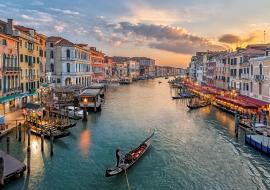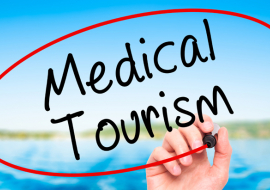Medical Tourism Growing in Central America

Medical Tourism Growing in Central America
(Source: Calvet Weekly News)
During this last two years, Medical Tourism has taken a very strong lead in Central America because of a sharp increase in medical services and insurance costs in the United States, the main market for patients for the world medical tourism industry, and because the incredible violence erupted in northern Mexico, that use to be a traditional medical tourism destination for north Americans. These two conditions have encouraged authorities and private investors to think seriously in the medical tourism business in countries like El Salvador, Honduras, Guatemala and Nicaragua. Costa Rica and Panama are already positioned in this market, especially Costa Rica.
In 2009, 3.3 million Americans alone traveled abroad for health care and spent over $80 million dollars, as reported by Deloitte. This numbers are expected to grow at a 74% growth rate per year. Deloitte also calculates about 45 million people with no medical insurance in the US. This tourism market segment is a very lucrative business and has been producing large revenue streams for countries like Costa Rica, Panama and now El Salvador in Central America. Millions of North Americans are travelling everyday more to foreign countries for medical treatment because of the extreme cost differentials.
Most destinations recognizing this potential have dedicated serious efforts and resources to improve the quality of their services and the level of their professional staff by obtaining internationally recognized certifications and working with specialized medical facilitators or logistic organizers.
To become a destination for medical treatments the infrastructure and medical services must be done properly and according to international standards and assemble a professional team of qualified medical doctors and nurses fluent in English. Operations and Management must be the responsibility of experienced and knowledgeable professionals.
Costa Rica, Panama and El Salvador have showed strong growth indicators above 15% per year for the medical tourism arrivals. Even though most facilities are closer to the main airport, there are a few examples or remote facilities that take this as an advantage to offer more suitable recovery and relaxation areas as well as more activities and amenities for the accompanying family members.
Once associated with cheap cosmetic surgery and fringe medical therapies, medical tourism (also known as health travel, medical travel, or global health care) is now rapidly gaining acceptance by both the American public and the medical community at large (the latter if somewhat reluctantly), as a real solution to the high cost of healthcare in the United States. In fact, the American Medical Association recently issued guidelines and recommendations for medical tourism patients traveling outside the U.S. for medical care.
Traditionally medical tourism has been associated with elective procedures (procedures not seen as strictly necessary) such as cosmetic dental and plastic surgery. Destinations such as Brazil, Costa Rica and Mexico have long catered to North American body worshippers in need of a nip or a tuck. Over the last few years however, non-elective procedures such as knee and hip replacements, cardiac procedures and neurosurgery have rapidly been gaining ground and are soon expected to overtake seemingly “trivial” pursuits such as searching for the perfect smile.
Asian nations such as India, Thailand and Singapore have taken the lead in marketing their hospitals and countries to this new wave of medical tourists, most of whom are baby boomers hailing from countries in North America, Europe and the Middle East. Not to be left behind, other countries in Asia, Latin America, and Europe are now catching up and have begun to successfully attract many of these same markets with enticing offers of cheaper prices, shorter flights and cutting edge technology.
For many years the USA was a main receptor of medical tourism patients searching for the cutting-edge medical expertise and technology. This is still the case to some degree; however, the number of incoming medical tourism patients has diminished significantly due in part to the stringent immigration restrictions on visas following the tragic events of 9/11.
Factors that have led to the increasing popularity of medical travel out of the USA and Canada include the high cost of health care, long wait times for certain procedures, the ease and affordability of international travel, and improvements in both technology and standards of care in many countries.
Medical tourists can come from anywhere in the world, including Europe, the UK, Middle East, Japan, the United States, and Canada. This is because of their large populations, comparatively high wealth, the high expense of health care or lack of health care options locally, and increasingly high expectations of their populations with respect to health care.
A large draw to medical travel is convenience and speed. Countries that operate public health-care systems are often so taxed that it can take considerable time to get non-urgent medical care.
The time spent waiting for a procedure such as a hip replacement can be a year or more in Canada; however, in Costa Rica, El Salvador, Panama, Singapore, Hong Kong, Thailand, Cuba, Colombia, Philippines or India, a patient could feasibly have an operation the day after their arrival. In Canada, the number of procedures in 2005 for which people were waiting over a year was 782,936.
Most popular medical travel worldwide destinations include: India, Brunei, Cuba, Colombia, Costa Rica, Hong Kong, Hungary, Jordan, Lithuania, Malaysia, The Philippines, Singapore, South Africa, Thailand, and recently, Saudi Arabia, UAE, Tunisia and New Zealand.
Most popular cosmetic surgery travel destinations include: Argentina, Bolivia, Brazil, Colombia, Costa Rica, Cuba, Mexico and Turkey. In South America, countries such as Argentina, Bolivia, Brazil and Colombia lead on plastic surgery medical skills relying on their experienced plastic surgeons. In Bolivia and Colombia, plastic surgery has also become quite common.
However, perceptions of medical tourism are not always positive. In places like the US, which has high standards of quality, medical tourism is viewed as risky. Nonetheless, the number of Americans who are going abroad for health care is increasing. In some parts of the world, wider political issues can influence where medical tourists will choose to seek out health care.
Health tourism providers have developed as intermediaries to unite potential medical tourists with provider hospitals and other organizations. Companies are beginning to offer global health care options that will enable North American and European patients to access world health care at a fraction of the cost of domestic care.
Companies that focus on medical value travel typically provide nurses to assist patients with pre and post-travel medical issues. They also help provide resources for follow-up care upon the patient’s return.
The Wellness and Alternative Medicine are a rapidly growing sub-niche of medical tourism that has been around for many years. It is technically two sub-niches (though they do overlap) as we must differentiate between travel for alternative treatments and wellness tourism.
The Medical Subject Headings Section staff of the National Library of Medicine classifies alternative medicine under the term complementary therapies. This is defined as therapeutic practices which are not currently considered an integral part of conventional allopathic medical practice.
Others would define it as any medical intervention not available at U.S hospitals. These “interventions” include but are not limited to certain cancer therapies, homeopathy, chiropractic, naturopathy, mega-vitamin therapy, herbalism, acupuncture, massage, and new age healing.
Wellness tourism, on the other hand, is characterized by generally healthy people seeking to preserve or promote their health through preventative care treatments such as medical check-ups, mega-vitamin therapy, yoga and meditation. However, the fact that each year more and more people are traveling abroad for medical care goes to show a simple truth:
For the nearly fifty million uninsured Americans who can’t afford quality healthcare, offering low-cost healthcare at top-quality international hospitals through Medical Tourism gives them an opportunity to access the medical treatments they need.
During this last two years, Medical Tourism has taken a very strong lead in Central America because of a sharp increase in medical services and insurance costs in the United States, the main market for patients for the world medical tourism industry, and because the incredible violence erupted in northern Mexico, that use to be a traditional medical tourism destination for north Americans. These two conditions have encouraged authorities and private investors to think seriously in the medical tourism business in countries like El Salvador, Honduras, Guatemala and Nicaragua. Costa Rica and Panama are already positioned in this market, especially Costa Rica.
In 2009, 3.3 million Americans alone traveled abroad for health care and spent over $80 million dollars, as reported by Deloitte. This numbers are expected to grow at a 74% growth rate per year. Deloitte also calculates about 45 million people with no medical insurance in the US. This tourism market segment is a very lucrative business and has been producing large revenue streams for countries like Costa Rica, Panama and now El Salvador in Central America. Millions of North Americans are travelling everyday more to foreign countries for medical treatment because of the extreme cost differentials.
Most destinations recognizing this potential have dedicated serious efforts and resources to improve the quality of their services and the level of their professional staff by obtaining internationally recognized certifications and working with specialized medical facilitators or logistic organizers.
To become a destination for medical treatments the infrastructure and medical services must be done properly and according to international standards and assemble a professional team of qualified medical doctors and nurses fluent in English. Operations and Management must be the responsibility of experienced and knowledgeable professionals.
Costa Rica, Panama and El Salvador have showed strong growth indicators above 15% per year for the medical tourism arrivals. Even though most facilities are closer to the main airport, there are a few examples or remote facilities that take this as an advantage to offer more suitable recovery and relaxation areas as well as more activities and amenities for the accompanying family members.
Once associated with cheap cosmetic surgery and fringe medical therapies, medical tourism (also known as health travel, medical travel, or global health care) is now rapidly gaining acceptance by both the American public and the medical community at large (the latter if somewhat reluctantly), as a real solution to the high cost of healthcare in the United States. In fact, the American Medical Association recently issued guidelines and recommendations for medical tourism patients traveling outside the U.S. for medical care.
Traditionally medical tourism has been associated with elective procedures (procedures not seen as strictly necessary) such as cosmetic dental and plastic surgery. Destinations such as Brazil, Costa Rica and Mexico have long catered to North American body worshippers in need of a nip or a tuck. Over the last few years however, non-elective procedures such as knee and hip replacements, cardiac procedures and neurosurgery have rapidly been gaining ground and are soon expected to overtake seemingly “trivial” pursuits such as searching for the perfect smile.
Asian nations such as India, Thailand and Singapore have taken the lead in marketing their hospitals and countries to this new wave of medical tourists, most of whom are baby boomers hailing from countries in North America, Europe and the Middle East. Not to be left behind, other countries in Asia, Latin America, and Europe are now catching up and have begun to successfully attract many of these same markets with enticing offers of cheaper prices, shorter flights and cutting edge technology.
For many years the USA was a main receptor of medical tourism patients searching for the cutting-edge medical expertise and technology. This is still the case to some degree; however, the number of incoming medical tourism patients has diminished significantly due in part to the stringent immigration restrictions on visas following the tragic events of 9/11.
Factors that have led to the increasing popularity of medical travel out of the USA and Canada include the high cost of health care, long wait times for certain procedures, the ease and affordability of international travel, and improvements in both technology and standards of care in many countries.
Medical tourists can come from anywhere in the world, including Europe, the UK, Middle East, Japan, the United States, and Canada. This is because of their large populations, comparatively high wealth, the high expense of health care or lack of health care options locally, and increasingly high expectations of their populations with respect to health care.
A large draw to medical travel is convenience and speed. Countries that operate public health-care systems are often so taxed that it can take considerable time to get non-urgent medical care.
The time spent waiting for a procedure such as a hip replacement can be a year or more in Canada; however, in Costa Rica, El Salvador, Panama, Singapore, Hong Kong, Thailand, Cuba, Colombia, Philippines or India, a patient could feasibly have an operation the day after their arrival. In Canada, the number of procedures in 2005 for which people were waiting over a year was 782,936.
Most popular medical travel worldwide destinations include: India, Brunei, Cuba, Colombia, Costa Rica, Hong Kong, Hungary, Jordan, Lithuania, Malaysia, The Philippines, Singapore, South Africa, Thailand, and recently, Saudi Arabia, UAE, Tunisia and New Zealand.
Most popular cosmetic surgery travel destinations include: Argentina, Bolivia, Brazil, Colombia, Costa Rica, Cuba, Mexico and Turkey. In South America, countries such as Argentina, Bolivia, Brazil and Colombia lead on plastic surgery medical skills relying on their experienced plastic surgeons. In Bolivia and Colombia, plastic surgery has also become quite common.
However, perceptions of medical tourism are not always positive. In places like the US, which has high standards of quality, medical tourism is viewed as risky. Nonetheless, the number of Americans who are going abroad for health care is increasing. In some parts of the world, wider political issues can influence where medical tourists will choose to seek out health care.
Health tourism providers have developed as intermediaries to unite potential medical tourists with provider hospitals and other organizations. Companies are beginning to offer global health care options that will enable North American and European patients to access world health care at a fraction of the cost of domestic care.
Companies that focus on medical value travel typically provide nurses to assist patients with pre and post-travel medical issues. They also help provide resources for follow-up care upon the patient’s return.
The Wellness and Alternative Medicine are a rapidly growing sub-niche of medical tourism that has been around for many years. It is technically two sub-niches (though they do overlap) as we must differentiate between travel for alternative treatments and wellness tourism.
The Medical Subject Headings Section staff of the National Library of Medicine classifies alternative medicine under the term complementary therapies. This is defined as therapeutic practices which are not currently considered an integral part of conventional allopathic medical practice.
Others would define it as any medical intervention not available at U.S hospitals. These “interventions” include but are not limited to certain cancer therapies, homeopathy, chiropractic, naturopathy, mega-vitamin therapy, herbalism, acupuncture, massage, and new age healing.
Wellness tourism, on the other hand, is characterized by generally healthy people seeking to preserve or promote their health through preventative care treatments such as medical check-ups, mega-vitamin therapy, yoga and meditation. However, the fact that each year more and more people are traveling abroad for medical care goes to show a simple truth:
For the nearly fifty million uninsured Americans who can’t afford quality healthcare, offering low-cost healthcare at top-quality international hospitals through Medical Tourism gives them an opportunity to access the medical treatments they need.














